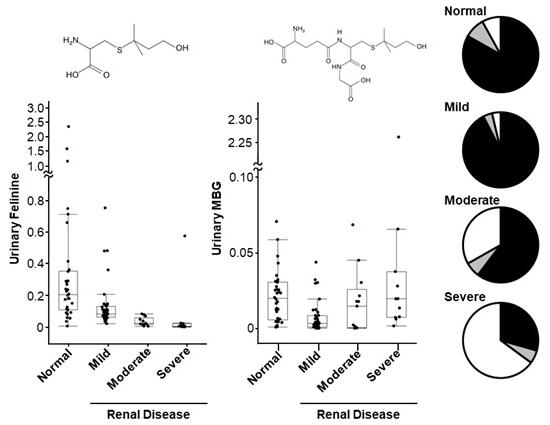Cat urine smells bad, but this weakened smell may indicate renal disease. Associate Professor Tamako Miyazaki, Professor Masao Miyazaki, and Graduate Student Ayaka Suka of the Faculty of Agriculture at Iwate University and their colleagues have found that in cats with advanced renal disease, the urinary excretion of felinine, an amino acid that is a precursor of the urinary odorants with catty odor, is reduced, and the foul smell of urine is weakened. If owners notice changes, such as "weaker urinary odor than before" or "urine with hardly any smell," when cleaning the cat litter, cats may be diagnosed with renal disease at an early stage and can receive treatment to delay the progression of renal disease at a veterinary clinic. The results provide a new perspective on cat health care. The study was published in the Journal of Veterinary Medical Science.

Provided by Iwate University
It is widely known that cats are intrinsically prone to renal disease. At least 50% of older cats reportedly have renal disease. Masao Miyazaki said, "I focused on cat urine because I noticed that the protein level in the urine of healthy cats was very high when I was a veterinary student. In humans, proteinuria is considered a sign of renal disease. This common sense does not apply to cats, so I became interested and began research."
Felinine is a unique amino acid found in cat urine and metabolized to sulfur-containing volatile substances, which are responsible for the unique catty urinary odor. Previously, the research group has been analyzing the felinine biosynthesis mechanism and the components of the urinary odorants in marking behavior in cats. In the current study, they measured urinary levels of felinine and its precursor, 3-methylbutanol glutathione (MBG), in 34 healthy cats and 66 cats with renal disease.
The emission levels of felinine-derived sulfur-containing volatile compounds such as 3-mercapto-3-methyl-1-butanol from urine were also analyzed to determine the relationship between the severity of renal disease and changes in these substances. The severity of renal disease was classified into three levels based on blood creatinine concentrations per deciliter: mild, 1.6−2.8 mg; moderate, 2.9−5 mg; and severe, >5 mg. Healthy cats had higher urinary felinine concentrations, but the concentration decreased markedly and progressively as the severity of renal disease increased. Particularly, felinine was barely detectable in many cats with severe renal disease.
Meanwhile, the urinary concentration of MBG did not decrease even in cats with advanced renal disease, indicating that the felinine-to-MBG ratio increased markedly with the severity of renal disease. This phenomenon is due to decreases in the enzymes responsible for converting MBG to felinine in the kidney.
The analysis of sulfur-containing volatile compounds showed a major decrease as the severity of renal disease increased. They confirmed that sulfur-containing volatile compounds are the major odorants constituting unique catty urinary odor and that the decreased excretion levels of these compounds are directly related to the weakened urinary odor.
Masao Miyazaki said, "Owners can also experience that the urinary odor is weakened when cats have renal disease. However, the analysis of odorants was unprecedented. Renal disease is associated with the reduced ability of the kidneys to concentrate primary urine, which is the urine source. Thus, cats with renal disease discharge dilute, water-like urine. Furthermore, some people thought that the smell would be weakened as the urinary odorants were diluted. Our results have shown for the first time that the urinary odor is weakened not just because the urine is diluted but also because the amounts of odorants are reduced. We are currently investigating the mechanism that explains why felinine is produced in large quantities only in cats in the first place."
Journal Information
Publication: Journal of Veterinary Medical Science
Title: Reduction of urinary felinine in domestic cats with renal diseases leads to decreased catty odor
DOI: 10.1292/jvms.24-0370
This article has been translated by JST with permission from The Science News Ltd. (https://sci-news.co.jp/). Unauthorized reproduction of the article and photographs is prohibited.




